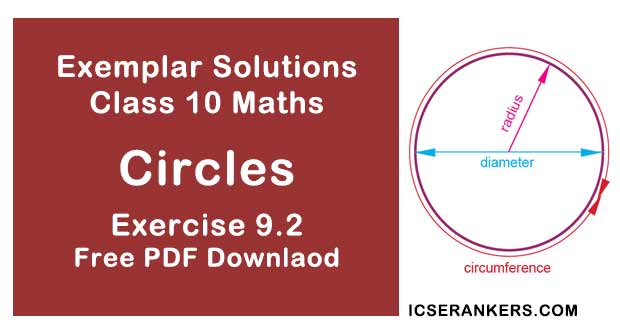Chapter 9 Circles NCERT Exemplar Solutions Exercise 9.2 Class 10 Maths

Chapter Name | NCERT Maths Exemplar Solutions for Chapter 9 Circles Exercise 9.2 |
Book Name | NCERT Exemplar for Class 10 Maths |
Other Exercises |
|
Related Study | NCERT Solutions for Class 10 Maths |
Exercise 9.2 Solutions
Short Answer Questions with Reasoning
Write ‘True’ or ‘False’ and justify your answer in each of the following:
1. If a chord AB subtends an angle of 60° at the centre of a circle, then angle between the tangents at A and B is also 60°.
Solution
False
Explanation:
Let us consider the given figure. In which we have a circle with centre O and AB a chord with ∠AOB = 60°
As, tangent to any point on the circle is perpendicular to the radius through point of contact,
We get,
OA ⏊ AC and OB ⏊ CB
∠OBC = ∠OAC = 90° ...eq (i)
Using angle sum property of quadrilateral in Quadrilateral AOBC,
We get,
∠OBC + ∠OAC + ∠AOB + ∠ACB = 360°
90° + 90° + 60° + ∠ACB = 360°
∠ACB = 120°
Therefore, the angle between two tangents is 120°.
And, we can conclude that, the given statement is false.
2. The length of tangent from an external point on a circle is always greater than the radius of the circle.
Solution
False
Explanation:
Length of tangent from an external point P on a circle may or may not be greater than the radius of the circle.
3. The length of tangent from an external point P on a circle with centre O is always less than OP.
Solution
True
Explanation:
Consider the figure of a circle with centre O.
Let PT be a tangent drawn from external point P.
Now, Joint OT.
OT ⏊ PT
We know that,
Tangent at any point on the circle is perpendicular to the radius through point of contact
Therefore, OPT is a right-angled triangle formed.
We also know that,
In a right angled triangle, hypotenuse is always greater than any of the two sides of the triangle.
So,
OP > PT or PT < OP
Hence, length of tangent from an external point P on a circle with center O is always less than
OP.
4. The angle between two tangents to a circle may be 0°.
Solution
True
Explanation:
The angle between two tangents to a circle may be 0°only when both tangent lines coincide or are parallel to each other.
5. If angle between two tangents drawn from a point P to a circle of radius a and centre O is 90°, then OP = a√2.
Solution
True.
Tangent is always perpendicular to the radius at the point of contact.
So, ∠OTP = 90
If 2 tangents are drawn from an external point, then they are equally inclined to the line segment joining the centre to that point.
Let us consider the following figure,
From point P, two tangents are drawn.
Given,
OT = a
Also, line OP bisects the ∠RPT
∠TPO = ∠RPO = 45°
Also,
OT ⊥ TP
⇒ ∠OTP = 90°
In right angled ∆OTP,
sin 45° = OT/OP
⇒ 1/√2 = a/OP
⇒ OP = a√2
6. If angle between two tangents drawn from a point P to a circle of radius a and centre O is 60°, then OP = a√3.
Solution
False
Explanation :
From point P, two tangents are drawn.
Given,
OT = a
Also, line OP bisects the ∠RPT.
∠TPO = ∠RPO = 30°
Also,
OT ⊥ PT
⇒ ∠OTP = 90°
In right angled ∆OTP,
sin30° = OT/OP
⇒ 1/2 = a/OP
⇒ OP = 2a
⇒ OP = 2a
7. The tangent to the circumcircle of an isosceles triangle ABC at A, in which AB = AC, is parallel to BC.
Solution








